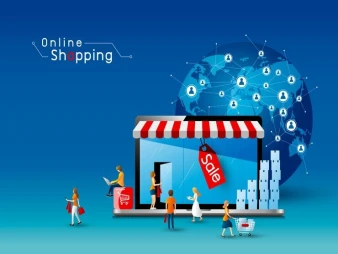Free support 24/7
Free support 24/7

What is competitive analysis?
Competitive analysis is the process of gathering and analyzing information about your competitors in the market, which can include their products, prices, strategies, customer bases, strengths and weaknesses. The goal of a competitive analysis is to understand your current market position, identify opportunities and threats to your business, and find ways to outperform or collaborate with your competitors.
Why is competitive analysis important for e-commerce?
E-commerce is a vibrant and dynamic industry, where every day new ventures appear trying to attract customer attention and increase market share. Therefore, competitive analysis is a valuable tool for e-entrepreneurs for many reasons:
It helps you define your project's unique value proposition, which should highlight the advantages of your product or service over other similar projects.
It helps you identify what your competitors are doing right, which can be used as best practices or inspiration for your business development.
It helps you identify your competitors' weaknesses, which can be used as opportunities to highlight the strength of your project or solve problems faced by customers.
It provides you with accurate and up-to-date market data, which helps you make strategic decisions based on numbers and facts.
It provides you with a frame of reference for measuring your project's performance, which helps you identify your strengths and weaknesses, and adjust your marketing and development plans.
How do you conduct a competitive analysis of your electronic project?
Conducting a competitive analysis of your electronic project is not difficult, if you follow simple and systematic steps. Here are eight steps you can take to conduct a comprehensive and effective competitive analysis:
1. Determine who your competitors are
The first step is to know who you are really competing with in the market, and who could pose a threat or opportunity to your business. You can divide your competitors into two categories: direct and indirect.
Direct competitors are projects that provide a product or service similar to what you offer, target the same category of customers, and operate in the same geographical or electronic field. For example, if your project is an online men's clothing store, your direct competitors will be other online stores that sell the same category of men's clothing.
Indirect competitors are projects that provide a different product or service than yours, but that meet the same need or solve the same problem for customers. For example, if your project is an online store selling men's clothing, your indirect competitors will be traditional stores that sell men's clothing in markets or malls.
There is no fixed rule for determining the number of your competitors, but it is preferable not to exceed five or six from each category, so as not to get lost in many details. You can use search engines like Google to do a keyword search that describes your business, and see the first page results, which will show you your top competitors. You can also use tools such as Samrush or Servicestat to conduct more accurate and in-depth research on your competitors and their performance.
2. Conduct a SWOT analysis
A SWOT analysis is a tool that helps you assess the strengths, weaknesses, opportunities and threats of your business and your competitors. You can create a table with four sections, each section representing one of the four factors, and containing a list of items related to it. For example:
Strengths Weaknesses
- High quality of products and services - High cost of production and marketing
- Good reputation in the market - Narrow range of target customers
Qualified and enthusiastic work team
Low capacity for expansion and innovation
Opportunities Threats
- Increased demand for men's clothing on the Internet - Entry of new competitors into the market
- Evolution of technology and e-commerce - Changes in customer behavior and preferences
- Partnerships with suppliers, influencers or other projects - Tightening laws and taxes or the occurrence of crises
You can conduct a SWOT analysis for your project as well as for each of your competitors, based on the information you collect from various sources, such as their websites, their pages on social media, ratings and opinions left by customers, or reports and research issued by specialized institutions. You can use some questions to help you conduct a SWOT analysis, such as:
What are the advantages that the customer gets from purchasing a product or service from this project?
What are the defects or problems that the customer faces from purchasing a product or service from this project?
What are the opportunities that this project can exploit to increase its market share or customer satisfaction?
What are the threats that prevent the success of this project or harm its performance?
3. Define key performance indicators
After conducting a SWOT analysis, you can identify key performance indicators (KPIs), which are the metrics that are used to measure the success of your business and your competitors. You can choose indicators commensurate with the objectives and nature of your project, and try to be few, clear and measurable. Some examples of e-commerce KPIs are:
The number of visits or views to your website or social media pages
The number of new, returning or loyal customers
Conversion rate or the percentage of visits that lead to a purchase
Average order value or the amount of money a customer spends on each purchase
Bounce rate, or the percentage of traffic that leaves your site quickly without taking any action
Cart abandonment rate, or the percentage of visits that add products to the cart but don't complete the purchase
Customer satisfaction index, or the degree to which customers are satisfied or dissatisfied with your products or services
You can use tools such as Google Analytics or Bing Web Master to track and analyze the KPIs of your project, as well as tools such as Samrush or Servicestat to compare KPIs between your project and your competitors. You can create a table containing a list of indicators that you choose, and their values for your project and your competitors, in order to determine your position in the market, and the gaps that need to be filled.
Ha, and the goals you need to achieve. For example:
Open in a browser
The indicator is your project Competitor 1 Competitor 2 Competitor 3
Number of visits (per month) 10,000 15,000 8,000 12,000
Number of customers (per month) 500 800 400 600
Conversion Rate (%) 5% 5.3% 5% 5%
Average order value (EGP) 200 180 220 190
Bounce Rate (%) 40% 35% 45% 40%
Cart abandonment rate (%) 60% 50% 70% 60%
Customer Satisfaction Index (%) 80% 85% 75% 80%
4. Determine the strategy of excellence
After you have identified the KPIs, you can define an outperformance strategy that aims to improve the performance of your project and differentiate it from your competitors. An excel strategy is an action plan that outlines the goals, actions, and resources you need to achieve satisfactory and sustainable results. You choose a strategy that fits your vision, values, and capabilities, and tries to be realistic, flexible, and innovative. Some examples of excel strategies for e-commerce are:
Focus on the quality of the product or service, which gives the customer added value and high confidence in your project. You can do this by choosing reliable suppliers, using high-quality materials and technologies, conducting periodic tests and warranties, listening to customer feedback and continuous improvement.
Focus on the price of the product or service, which gives the customer an economic benefit and an incentive to buy from your project. You can do this by reducing fixed and variable costs, increasing production and distribution efficiency, conducting feasibility and market studies, and using appropriate pricing strategies, such as competitive pricing, penetration pricing, or psychological pricing.
Focus on the customer experience, which gives the customer emotional satisfaction and loyalty to your project. You can do this by designing an attractive and easy-to-use website, adding useful and interesting content, establishing effective communication channels with customers, and providing after-sales services such as free delivery, return, exchange or warranty.
Focusing on uniqueness or specialization, which gives the client a positive difference from other similar projects. You can do this by creating a new or improved product or service, targeting an unsatisfied or special needs customer group, or adding social, environmental or cultural value to your project.
5. Applying the superiority strategy
After you have defined the strategy of excellence, you can apply it to your project in a practical and systematic manner. You can do this by creating an action plan that sets SMART goals, which are specific, measurable, realistic, relevant, and time-bound. The plan also outlines the actions, tasks, responsibilities, resources, and schedules you need to implement the goals. Some examples of smart goals for e-commerce are:
Increase the number of visits to your website by 20% within three months, through search engine optimization (SEO), launching advertising campaigns on social media, and creating new and useful content.
Increasing the conversion rate by 10% within six months, by offering attractive offers and discounts, simplifying the purchase process, adding customer reviews and ratings, and improving site speed and security.
Increase the value of the average order by 15% within a year, by offering complementary or related products, creating loyalty programs, points or gifts, and increasing repeat or joint orders.
6. Measuring the results of the superiority strategy
After you have applied the strategy of excellence, you must measure its results periodically and continuously. You can do this by monitoring the KPIs you have chosen, comparing them to the targets you have set, and determining the level of verification or non-verification. You can also use tools such as Google Analytics or Bing Web Master to generate reports and statistics on your project's performance, as well as tools such as Samrush or Servicestat to compare your project's performance with that of your competitors. You can create a table containing a list of the indicators you have chosen, the goals you have set for them, and the results you have obtained, in order to determine the degree of success of your excel strategy, and the variances you need to make.
Plug it in, and the recommendations you need to follow. For example:
Indicator Target Outcome Evaluation Recommendation
Number of visits (monthly) 12,000 11,000 achieved by 91.7% increase in advertising and content campaigns
Number of customers (per month) 600 550 Achievement rate of 91.7% Improve offers and discounts for new customers
Conversion Rate (%) 5.5% 5% Achievement 90.9% Simplify the buying process and increase customer confidence
Average Order Value (EGP) 230 210 Achieved by 91.3% Providing complementary or related products
Bounce rate (%) 35% 40% Not achieved 87.5% Improving the speed and security of the site and adding attractive content
Cart abandonment rate (%) 55% 60% Not achieved 91.7% Provide after-sales services and return, exchange or guarantee
Customer Satisfaction Index (%) 85% 80% Achieved by 94.1% Establish effective communication channels with customers and listen to their opinions
7. Updating the excel strategy
After you have measured the results of your superiority strategy, you must update it periodically and continuously. You can do this by reviewing the goals, procedures, resources and timelines you have set, and making the necessary adjustments to improve your project performance and adapt to changes in the market. You can also use tools such as Google Analytics or Bing Web Master to track and analyze the performance of your project, as well as use tools such as Samrush or Servicestat to monitor the performance of your competitors and changes in their strategies. You can create a table containing a list of the indicators you chose, the goals you set for them, the results you obtained, and the changes you made, in order to adjust the strategy of excellence and increase its effectiveness and effectiveness. For example:
Indicator Objective Outcome Evaluation Change
Number of visits (monthly) 12,000 11,000 Achieved by 91.7% Advertising budget increased by 10%
Number of customers (per month) 600 550 Achievement rate of 91.7% Offer 20% discount to new customers
Conversion rate (%) 5.5% 5% achieved by 90.9% Add certificates and guarantees for products
The value of the demand
Medium (EGP) 230 210 Check 91.3% Provide a free gift for orders over 300 EGP.
Bounce rate (%) 35% 40% Not achieved 87.5% Improving the speed and security of the site and adding attractive content
Cart abandonment rate (%) 55% 60% Not achieved 91.7% Provide after-sales services and return, exchange or guarantee
Customer Satisfaction Index (%) 85% 80% Achieved by 94.1% Establish effective communication channels with customers and listen to their opinions
8. Repeat the competitive analysis process
After you have updated your superiority strategy, you must repeat the competitive analysis process periodically and continuously. You can do this by reviewing who your competitors are, conducting a SWOT analysis, identifying performance indicators, applying a superiority strategy, measuring its results, and updating them, in order to ensure the continued success and development of your project in light of the fierce competition in the e-commerce market.
I hope this article was useful to you, and that it helped you to conduct a competitor analysis for your e-project effectively and easily.

Flash sales are not just a temporary marketing tool. They are a smart tool to quickly drive sales and increase engagement in your store

تعرف على الطريقة الذكية اللي تخليك تستفيد من تجارب عملاءك السابقين في تسويق منتجاتك الجديدة وزيادة المبيعات
You can create your store easily